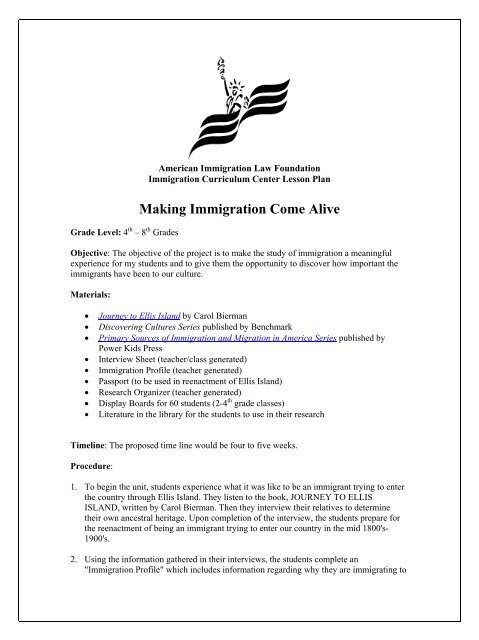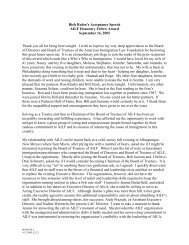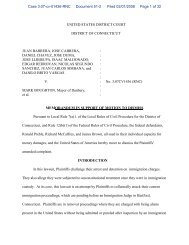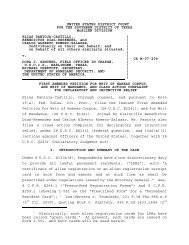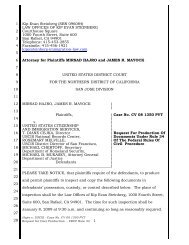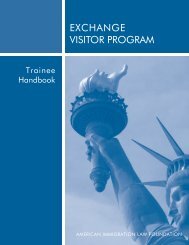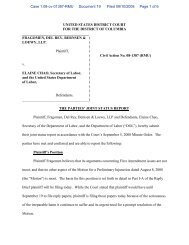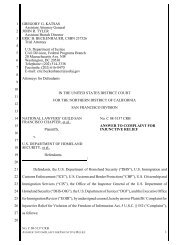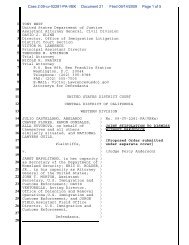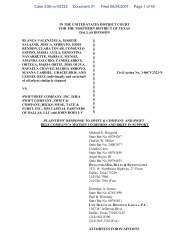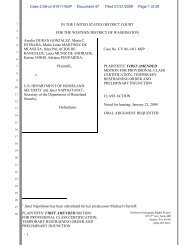MAKING IMMIGRATION COME ALIVE - American Immigration Council
MAKING IMMIGRATION COME ALIVE - American Immigration Council
MAKING IMMIGRATION COME ALIVE - American Immigration Council
- No tags were found...
Create successful ePaper yourself
Turn your PDF publications into a flip-book with our unique Google optimized e-Paper software.
Grade Level: 4 th – 8 th Grades<strong>American</strong> <strong>Immigration</strong> Law Foundation<strong>Immigration</strong> Curriculum Center Lesson PlanMaking <strong>Immigration</strong> Come AliveObjective: The objective of the project is to make the study of immigration a meaningfulexperience for my students and to give them the opportunity to discover how important theimmigrants have been to our culture.Materials:• Journey to Ellis Island by Carol Bierman• Discovering Cultures Series published by Benchmark• Primary Sources of <strong>Immigration</strong> and Migration in America Series published byPower Kids Press• Interview Sheet (teacher/class generated)• <strong>Immigration</strong> Profile (teacher generated)• Passport (to be used in reenactment of Ellis Island)• Research Organizer (teacher generated)• Display Boards for 60 students (2-4 th grade classes)• Literature in the library for the students to use in their researchTimeline: The proposed time line would be four to five weeks.Procedure:1. To begin the unit, students experience what it was like to be an immigrant trying to enterthe country through Ellis Island. They listen to the book, JOURNEY TO ELLISISLAND, written by Carol Bierman. Then they interview their relatives to determinetheir own ancestral heritage. Upon completion of the interview, the students prepare forthe reenactment of being an immigrant trying to enter our country in the mid 1800's-1900's.2. Using the information gathered in their interviews, the students complete an"<strong>Immigration</strong> Profile" which includes information regarding why they are immigrating to
this country and their reasons for leaving their homeland. Next, we discuss the use ofpassports. The students make a passport to use to enter the country during thereenactment of Ellis Island.3. Students reenact a group of immigrants arriving in Ellis Island. They go through thestations that the immigrants had to pass through (medical examiner, medical specialists,government inspector, and board of inquiry). Some students will not be allowed into thecountry. After the simulation, discuss what it felt like to go through the process (theanticipation of arriving at Ellis Island, their feelings when they were allowed to stay inthis country and their feelings when they were told they would have to return to theirhomeland).4. Students can pick one country of their ancestors to research. Ask them to gatherinformation regarding that country. Information may include location, landforms,climate, economy, clothing, customs, and celebrations. They will also complete aRESEARCH ORGANIZER (attached) to guide them. Students research contributions toour culture by the immigrants from their chosen country. These might include famouspeople such as inventors, musicians, artists, or such things as foods, recipes, clothing,words, and celebrations that we have adopted into our culture.5. Each student will eventually share their research in the form of a display board which,after the classroom presentation, will be on display in our school library for the studentbody to see.6. The display board should include a world map with a map key noting where theirancestors came from, as well as a map of the country they researched. A flag of theirresearched country and the United States flag may also be represented on the board. Inaddition, the display board must include five things that they have learned about thecountry they researched. The students might also include a paragraph explaining thecontributions of the immigrants to our country.7. This project is a collaboration of the classroom teacher, the librarian, and the computerteacher. The librarian can find the literature and websites necessary for the students to useto complete their research. The computer teacher can help the students generate all thematerial that will go on the display board. The display board will be completely computergenerated.8. The final part of this project culminates in a classroom presentation by each student abouttheir country and how our country has benefited from the immigrants coming to theUnited States. The display boards will then go to the Library for the entire student bodyto see.
PROJECT OUTLINE1. Explain unit. ..<strong>Immigration</strong>• Overview• Interview• Re-enact going through Ellis Island• Choose country of ancestors to research• Create display board• Share display board with class2. Build background on immigration• Read JOURNEY TO ELLIS ISLAND by Carol Bierman• Discuss3. Take a virtual tour of Ellis Island• Use websitehttp://teacher.scholastic.com/activities/immigration/tour/indexlhtm• Use website to read about 3 children who recently immigrated to U.S.4. Re-enact the immigration process @ Ellis Island• Complete <strong>Immigration</strong> Profile (Sheet #1)• Complete Passport (Sheet #2)• Role play process as immigrants (Sheet #3)• 8th grade students will man stations• Some students will pass through and have their passportstamped...others will not be able to enter the country• Discuss the feelings involved when going through the process(anticipation, excitement, disappointment, anger)• Relate to the immigrants5. Begin tracing family immigration• Introduce students to www.EllisIsland.org. (might be able to findancestors)• Interview parents or grandparents (See sheet #4)• Share interview with classmates6. Begin Research• Pick a country of one of your ancestors to research• Explain what is expected (See sheet # 5)• Gather information using Country research worksheet (See sheet #6)• Use new books purchased w/ grant money• Discovering Culture Series• Primary Sources of <strong>Immigration</strong> and Migration in America Series
7. Create Display Boards• Done in computer class• Use websites provided:Atlapedia (www.atlapedia.com)Information on "countries A to Z"• Cyberschoolbus (http://www.un.org/Pubs/CyberSchoolBus/)Information on many countries from the United Nations• Infoplease (http://www.infoplease.com/)An online almanac with basic information including a countrymap and flag, all in alphabetical order.• Geographia (www.geographia.com/)A website with interesting tourist information, but you need toknow which continent your country is on.• KidsClick (www.kidsclick.org/)Links provided for some popu1ar countries.• World Almanac for Kids (www.worldalmanacforkids.com/)Another almanac resource8. Share with class• Display boards displayed in library for the rest of the school to see9. Assessed using rubric (See sheet #7)
<strong>MAKING</strong> <strong>IMMIGRATION</strong> <strong>COME</strong> <strong>ALIVE</strong>LESSON PLAN OUTLINEExplain unit. ..<strong>Immigration</strong>• Overview• Interview• Re-enact going through Ellis Island• Choose country of ancestors to research• Create display board• Share display board with classBuild background on immigration• Read JOURNEY TO ELLIS ISLAND by Carol Bierman• DiscussTake a virtual tour of Ellis Island• Use website http://teacher.scholastic.com/activities/immigration/tour/indexlhtm• Use website to read about 3 children who recently immigrated to U.S.Re-enact the immigration process @ Ellis Island• Complete <strong>Immigration</strong> Profile (See sheet #1)• Complete Passport (See sheet #2)• Role play process as immigrants (See sheet #3)o 8 th grade students will man stationso Some students will pass through and have their passport stamped...others will not be able toenter the country• Discuss the feelings involved when going through the process (anticipation, excitement,disappointment, anger)• Relate to the immigrantsBegin tracing family immigration• Introduce students to www.EllisIsland.org. (might be able to find ancestors)• Interview parents or grandparents (See sheet #4)• Share interview with classmatesBegin Research• Pick a country of one of your ancestors to research• Explain what is expected (See sheet # 5)• Gather information using Country research worksheet (See sheet #6)o Use new books purchased w/ grant moneyo Discovering Culture Serieso Primary Sources of <strong>Immigration</strong> and Migration in America SeriesUse websites provided:AtlapediaInformation on "countries A to Z"CyberschoolbusInformation on many countries from the United NationsInfopleaseAn online almanac with basic information including a country map and flag, all in alphabetical order.GeographiaA website with interesting tourist information, but you need to know which continent your country is on.
KidsClickLinks provided for some popu1ar countries.World Almanac for KidsAnother almanac resourceCreate Display Boards• Done in computer classShare with class• Display boards displayed in library for the rest of the school to seeAssessed using rubric (See sheet #7)
, IMMIGRANT PROFILEName: First Middle LastBirthdate:Month, Day, Year.Birthplace: Town or Village CountryCountry of DestinationWhy I'm leaving my homeland:Here's who I will travel with:Here's who I will leave behind:Here's what J need to bring with me:My reasons for bringing it:1. _2. _
IMMIGRANT PROFILE3. _4. _5. _Here's how I will travel:This is the route I will take:Here's what I will need to sell in order to make the trip:This is the money I hope to make:1. _2. _3. _4. _5. _Here's how I plan to spend and save the money I make:Here's where I will live and how I plan to support myself when I arrive:
PERSONAL PROFILE,MEDICAL INFORMATION";-.Height:Eye color:_Healthy? _.yes / _no If no, list illnesses:Hair color:_Age: __Any special needs?Nationality:' _ Any hearing problems? yes / noReason for <strong>Immigration</strong>: _ Any vision problems? yes / no Glasses? yes / noTRAVEL LOGLanguages spoken: ___ Country of Origin: _Trade, if any: _ Country of Destination: _Traveling alone: yes / no Mode of travel: _If no, who are you traveling with? _ What countries have you passed through in yourjourney?_How many people in your party?Any animals/pets?__2A3A
Department of <strong>Immigration</strong> SealPort of Entry:_Date of Arrival:_Box for "approved" stampName:Check one: Male FemaleBirth Date:_4ABirth Place:_
Social StudiesEllis IslandEllis Island was an immigrant processing center that wasopen from 1892 until 1952. During that time, over 12million immigrants entered the United States through EllisIsland. Today, more than four out of every ten <strong>American</strong>people can trace their roots to an ancestor who enteredAmerica through Ellis Island. Built to process 5,000 newimmigrants each day, it often processed twice that number.Once the immigrants stepped off their boats, largenumbered tags were tied to their clothing. They weretaken to the registry hall where, after waiting in long lines, they were examined by doctors. Chalkmarks were put on their clothing if any medical problems were suspected. Anyone whose clothing wasmarked was detained for further examination. About one out of,every six people were delayed for aslong as four days because of medical problems, and one out of every ten of those delayed were sentback to their homelands because the problems were judged to be serious. Those who made it past themedical examination were then questioned by a government inspector. If any answer was suspect, theperson would face a board of special inquiry who would decide if the person could stay. If all testswere passed, the average stay on Ellis Island was about five hours.SimulationHave students reenact a group of immigrants' arrival to Ellis Island. All of the students will beimmigrants, except for nine students who will play the roles mentioned below.Have one student hand out tags with numbers to be taped to the immigrants' clothing. One student willact as the medical examiner. He or she will look in the immigrants' eyes, ears, and mouths. Themedical examiner may choose about one out of every five immigrants to see the specialist. The personacting as the medical specialist will determine whether the person should be sent back or allowed toremain. The immigrants who pass the medical examination will then be sent to the governmentinspector. This person will choose to ask each immigrant some of the following questions:What is your name?How old are you? Are you married?What is your occupation? Can you read or write?Where are youfrom?Where are you going in the United States? How will you get there?Did you pay for your passage? If not, who did?How much money do you have with you?Do you have any relatives in the United States? Names and addresses of relatives?Have you ever been to the United States before? When and where?Have you ever been in prison?How is your health?Any immigrant who seems unsure of an answer will be sent to a special inquiry board made up of fivestudents, who will continue to ask similar questions. At the end ofthe questioning, they will vote todetermine whether the person will be allowed to remain in the United States. Follow the simulationwith a discussion.
<strong>IMMIGRATION</strong> PROJECT1. Interview a relative using the worksheet "WHERE DID MY FAMILY<strong>COME</strong> FROM? (This will be collected.)2. Choose a country that one of your ancestors came from toresearch.3. Gather information on your country using the COUNTRYRESEARCH worksheet. Complete the RESEARCH worksheetusing the Internet links provided on the SAS website. (This will becollected.)4. Organize this information on a display board so everyone canlearn about your country and the contributions of the immigrantsfrom your country.Your display should include the following:• A creative title that includes your name and the name of yourcountryEXAMPLE----KATIE'S TRIP TO CHINABOB'S VISIT TO GERMANY• A world map (provided by Mrs. Curran) shoWing all thecountries that your ancestors lived before immigrating to theUnited States• A map of the country you are researching
• Flags: The <strong>American</strong> flag and the flag representing yourcountry• 5 pieces of information about your country (refer to theCOUNTRY RESEARCH worksheet• A paragraph describing the contributions of immigrants fromyour country to the US.
COUNTRY RESEARCHCountry you're studying:Why did you choose to research this country?__Below is a list of the information you need to find during yourresearch.Basic FactsCapital--------------------Population (latest figure)_Language spoken_EconomyType of currency (moneY)L--_Major industries: What do they make?1.2.GeographyWhat continent is this country located on7:-.What countries border this nation?__
What bodies of water border this nation?What is the weather and climate like?What landforms are found in this country?Customs and CultureName three types of traditional/ popular food:What are the important holidays or celebrations there?What would be considered traditional clothing in this country?
What is your country's favorite sport or pastime?What are some contributions of immigrants from your country to theu.s.?Interesting Facts:Write down other interesting information that you find---at least threeinteresting facts:1.2.3.4.5.
<strong>IMMIGRATION</strong> PROJECT RUBRICNAME:------------------------Where Did My Family Come From? (10 points)Country Research (40 points)Neatness (5 points)No spelling errors, necessary punctuation, correctCapitalization (5 points)Information is complete (30 points)Display (50 points)Title---includes your name and country (5 points)--------US flag and country flag (5 points) --------------------------------World Map labeled w/map key (5 points)--------------------Map of co untry (5 points )---~-------------------------------------------5 Interesting Facts (20 points) ------------------------------------ _Parag raph (1 0 points)----------------------------------------------Total (100 points)
<strong>MAKING</strong> <strong>IMMIGRATION</strong> <strong>COME</strong> <strong>ALIVE</strong>THE REPORTWhen I wrote my proposal for this grant I stated that my objective for this project was tomake the study of immigration a meaningful experience for my students and to give themthe opportunity to discover how important the immigrants have been to our culture. Ibelieve I accomplished my goal. Each day that my class worked on the unit broughtanticipation. They enjoyed the unit!The book, JOURNEY TO ELLIS ISLAND, sparked the students curiosity about what itwas like to be an immigrant trying to enter this new world full of opportunities. It was agood stepping-stone into the unit.The reenactment of Ellis Island was an experience that will not be forgotten. The studentsspent two days doing the paperwork to enter Ellis Island. When the big day came, theywere excited and nervous. What if they weren't allowed to enter the country? With thehelp of 8 th grade students my class was able to experience the feelings of the immigrantsentering the U.S. There was excitement when they were allowed into the country. Therewas disappointment and even a few tears when they were not allowed into the country.There were even a few students who became angry when they were told they would notbe able to stay in the country. Classmates tried to console and cheer up those who wereupset and disappointed. During the discussion that followed some questions came upsuch as "Why wasn't I allowed to come into the country? They never told me." Anotherbrought up the point that he had sold everything to come to this country and now he is notallowed to stay. This was a very meaningful experience!Next came finding out about their own ancestors. A couple students discovered theirancestors were royalty in Europe. Some discovered their ancestors came from Irelandbecause of the potato famine. Others found out their ancestors came from places they hadnever heard of. The class enjoyed sharing their information and learning about eachothers ancestors.With the help of the Media Specialist and Computer teacher the students completed theresearch and display board. They were very excited when they found the contributions toour culture.When the unit was completed I felt that the students had a good understanding of<strong>Immigration</strong>. As a teacher it is very rewarding when you see the light bulb turn on withone student. At the end of the year my class had an assignment to write about a bestmemory of fourth grade. There were eight students who wrote about the <strong>Immigration</strong>Unit. My goal was accomplished!


